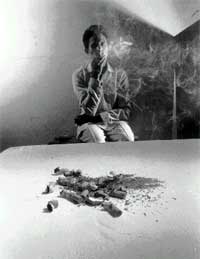Fumes and wrinkles
 if you smoke and are on the younger side of life, take another look at the mirror on the wall. You might just be sporting a wrinkled face with gaunt looking features.
if you smoke and are on the younger side of life, take another look at the mirror on the wall. You might just be sporting a wrinkled face with gaunt looking features.
A grim face with prominent underlying bones and a shriveled skin that is grey with purplish blotches, could be the outcome of your smoking habits. Douglas Model of Eastbourne, uk, added this condition, called the smokers face, to the medical lexicon. He correctly identified around half the smokers by their facial features alone. These distinctive features, which made the smokers appear far older than their years, were present in 46 per cent of those who smoke and eight per cent of those who had been smokers, regardless of age, social class, recent weight fluctuations and exposure to sunlight.
Smoking causes the thickening and fragmentation of elastin, the elastic fibres that are long and smooth in healthy skins. The reduction in the circulation of blood causes the depletion of oxygen in the skin. Smoking also decreases the formation of collagen, the skin's main structural component and dehydrates it. The overall impact of all these effects results in wrinkling.
Smoking also interferes with the skin's ability to protect itself against damage caused by free radicals in tobacco, which are highly reactive. In women, smoking brings down the level of circulating estrogen, which leads to dryness and disintegration of the skin tissues. Further, women who smoked had larger scars while undergoing exploratory abdominal surgery.
Smoking also decreases the wound healing capacity of the body. Surgeons have substantial reports to support the fact that smoking delays wound healing. Delayed wound healing is due to constriction of surface blood vessels, which reduce oxygen supply in the blood and thicken blood which prevents laying down of collagen needed for healing.
Palmoplantar pustulosis, a difficult-to-treat disease resembling psoriasis, occurs on the palms and soles of feet almost exclusively in smokers. The skin blisters, then form a scaly rash. Quitting the habit also does not do away with the disease. Apart from affecting the face of the smokers, red pimples due to inflammation in the openings of salivary glands, caused by tars and heat of tobacco smoke, depressions on tongue surface, and more serious lesions, leukoplakia, (white patches in the mouth) are also many times more common in smokers than in non-smokers. A blood vessel disease called Buergers Disease which causes poor circulation in the lower legs and causes skin problems like burning, tingling and ulceration, is one more in the long list of problems caused by smoking. Crohn's disease, which can cause big ugly looking ulcerations, most often on the legs and aching red nodules, usually on the lower legs, is also a consequence of smoking. Systemic lupus erythematous, an autoimmune disease that can cause hairloss, rashes on the face, scalp, hands and elsewhere, is also more common among smokers.
